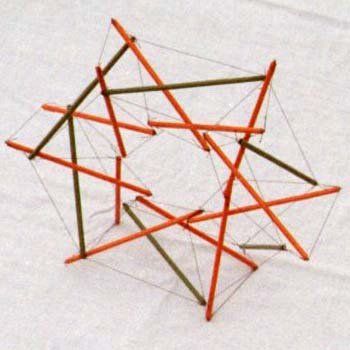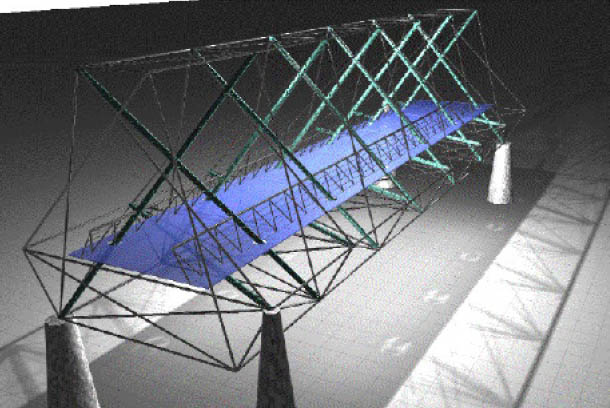
Wheel I

In his Master's thesis, Tensegrity Structures and their Application to Architecture (Belfast, Northern Ireland: Queen's University, School of Architecture, 2004, p. 100), and his book (Tensegridad: Estructuras Tensegríticas en Ciencia y Arte, Santander, Spain: Servicio de Publicaciones de la Universidad de Cantabria, 2007, pp. 133-134), Valentín Gómez Jáuregui has a preliminary plan for a footbridge (pasarela in Spanish) based on tensegrity technology (see Figure H.11 from his thesis below). I found his design interesting and thought maybe there was something to be learned by wrapping the modular bridge design around into a wheel. This design was the result. Many of Val's original tendons have been eliminated and things have been adjusted so all the struts are equal length. I think it confirms the validity of his approach and allows his proposal to be analyzed without having to deal with how the ends are handled. His preliminary design neglects this aspect.

Val's Fig. H.11: Footbridge from assembly of "Simplex" modules
It seems to me this approach may be useful for analyzing other modular proposals for tensegrity bridges and may yield useful design information for the bridge as well as potentially useful tensegrity wheel designs. Geometrically, this seems an interesting intermediate between prism and torus designs. This first wheel design was completed August 15, 2005, and is available in the Tensegrity Viewer as "Wheel I (Gómez Jáuregui module)". A VRML model is also available. On September 25, 2007, I put together a datasheet for this design. I completed assembly of a model on October 10, 2007, a photo of which is up at the top of this page. Among other things, the model drove home the point that this is the first toroidal tensegrity I've assembled that can stand easily on its edge.
A couple days later, I designed another wheel with the same module, but this time with the base of the module pointing inward instead of outward. The tendons are slightly different from the first wheel as well. The three struts in each stage make comparisons with tensegrity tori based on three-fold prisms inevitable. Playing with the module certainly stimulates thought about how the tendon connections between and within stages can be varied to achieve various design goals. I feel I've barely touched on the possibilities.

Wheel II
This second wheel design was completed August 17, 2005, and is available in the Tensegrity Viewer as "Wheel II (Gómez Jáuregui module)". A VRML model is also available. On September 25, 2007, I put together a datasheet for this design. I completed assembly of a model on January 1, 2008. As I suspected, this model won't stand on its edge, but it makes a fine prism. One of its interesting features, which I didn't notice until I assembled the model, is that, contrary to a regular tensegrity prism, it has an inner lining made only of tendons. This lining would allow the insertion of a spherical or disc-shaped object which would be suspended without touching any of the struts. The struts would then serve as a sort of exoskelton or case to protect this perhaps delicate object.


